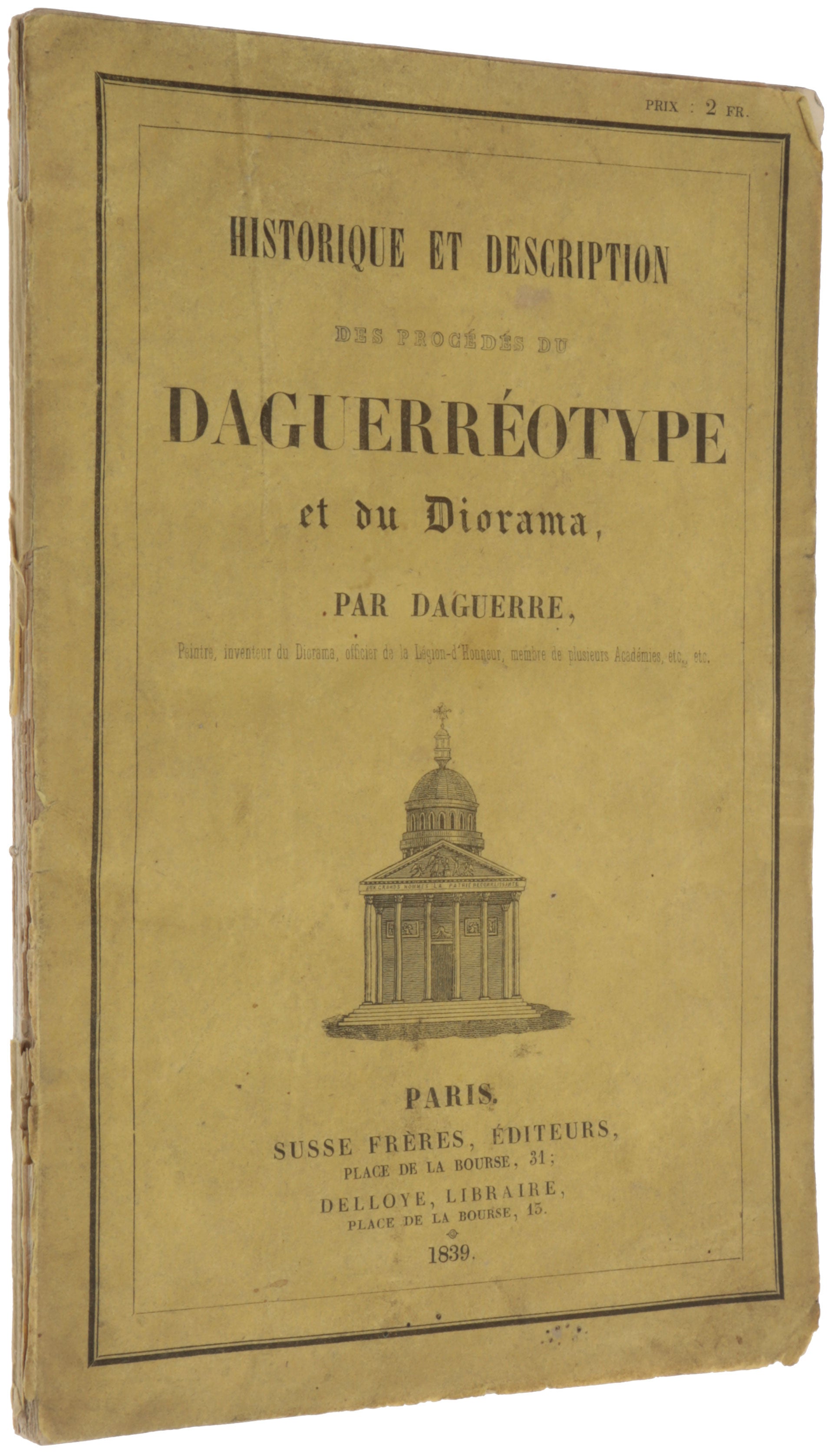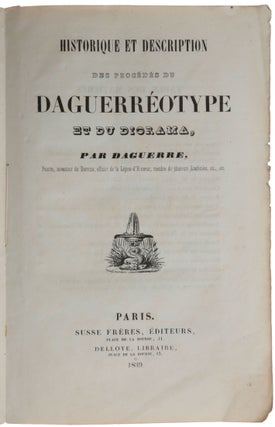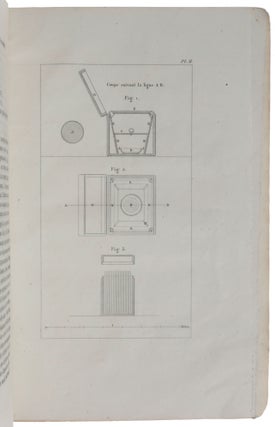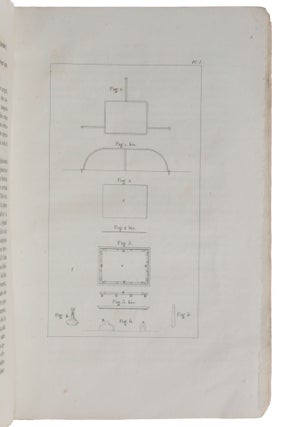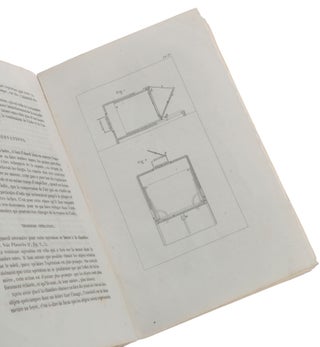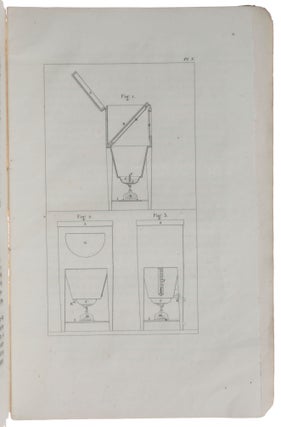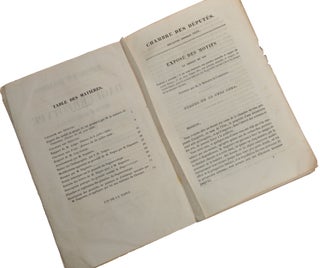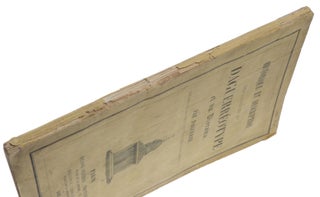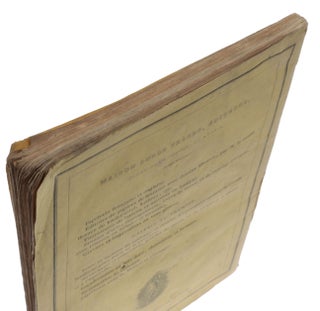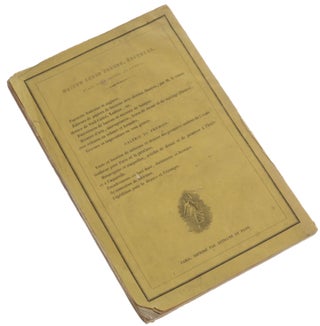Historique et description des procédés du daguerréotype et du diorama.
Paris: Béthune and Plon for Susse frères and Delloye, 1839. First edition, the true first issue (see below), of Daguerre’s exposition of his photographic process, “the beginnings of photography” (Horblit); this is an excellent unrestored copy in original printed wrappers, and very rare in this condition. “Perhaps no other invention ever captured the imagination of the public to such a degree and conquered the world with such lightning rapidity as the daguerreotype” (Gernsheim, p. 71). “The daguerreotype is a photographic image with a mirror-like surface on a silver or silver-coated copper plate. A unique photograph, the daguerreotype is not produced from a negative, and the final image appears either positive or negative depending on the angle of reflected light” (Hannavy, p. 365). Daguerre (1787-1851), a gifted set designer and creator of the famous Diorama, a picture show based on lighting effects, began experimenting in the 1820s with fixing the images of the camera obscura on silver chloride paper. His lack of success stimulated his interest in the heliographic method invented by Nicéphore Niépce (1765-1833), who had produced the first successful photographic image in 1826 or 1827 on a pewter plate coated with bitumen of Judea dissolved in oil of lavender, and in 1829 Daguerre succeeded in persuading the reluctant Niépce to become his partner. After Niépce’s death in the spring of 1835, Daguerre serendipitously discovered a quicker method of exposing and developing the Niépcian image through the application of mercury vapour. Using this method, with common table salt as the fixative, he produced his first successful permanent photographic image in 1837. On August 19, 1839 the scientist-politician François Arago (1786-1853) made a full announcement of the new process to a packed house at a joint meeting of the Académies des Sciences and des Beaux-Arts at the Institut de France. According to Beaumont Newhall, the first issue of Daguerre’s manual, published by order of the government, was released on or about 20 August 1839 and bears the imprint of Giroux et Cie, and Delloye; only two institutional copies of this issue are known. Pierre Harmant, however, has convincingly demonstrated that Newhall was in error in assigning the Giroux issue priority of publication, and that the present issue, released for sale on 14 September, printed by Béthune et Plon, and with the imprint of Susse Freres, Editeurs, and Delloye, was in fact the true first publication of Daguerre’s Manual, as it was called (see below for further details of Harmant’s argument). A total of 39 reprints, new editions, and translations appeared in the following 18 months. The great demand accounts for the profusion of issues of the first edition: seven are recorded, all from the same basic setting of type. Of these the first four differ in the booksellers’ names alone. Only three copies of this printing in unrestored original printed wrappers have appeared at auction since Honeyman: those of Richard Green (Christie’s New York, 2008), Marie-Thérèse & André Jammes (Sotheby’s Paris, 2002), and Meyer Friedman (Sotheby’s New York, 2001). The Norman copy, which realised $40,250 in 1998, was rebound with the original wrappers bound in, the wrappers “defective and laid down” (Norman sale catalogue). “Louis-Jacques Mandé Daguerre was born on 18 November 1787 at Cormeilles-en-Parisis. His childhood was spent at Orleans, where his father was employed as a clerk on the royal estate. Showing talent for drawing, the boy was apprenticed to an architect at the age of thirteen, and three years later became a pupil of Degotti, scene painter at the Paris Opera. Later he made himself independent and designed the decor for the productions of several Paris theatres. He also collaborated with Prevost on a number of large panoramas – a kind of show which enjoyed immense popularity in the last decade of the eighteenth and first half of the nineteenth centuries … In 1822 Daguerre associated himself with the painter Charles Bouton (an assistant of Prevost) in a new venture, the Diorama, a picture show with changing light effects which aroused astonishment and admiration by its perfect illusion of reality” (Gernsheim, p. 65). The realism of the paintings in the Diorama, which so impressed Daguerre’s audiences, was achieved by tracing images projected by a camera obscura. “Was it not natural that he, like Fox Talbot some years later, should have wished to find a method by which the fugitive image, which he was so laboriously tracing, could be made to delineate itself? Obsessed by this idea, Daguerre equipped a laboratory at the Diorama near the Place de la République in Paris, and there for several years he carried out mysterious experiments, shutting himself in his workroom for days on end. The famous chemist, J. B. Dumas, relates that Madame Daguerre consulted him one day in 1827 as to whether or not he thought it possible that her husband would be able to fix the images of the camera. ‘He is always at the thought; he cannot sleep at night for it. I am afraid he is out of his mind; do you, as a man of science, think it can ever be done, or is he mad?’ ‘In the present state of knowledge’, replied Dumas, ‘it cannot be done; but I cannot say it will always remain impossible, nor set the man down as mad who seeks to do it’” (ibid., p. 66). Daguerre’s fortunes changed only when he came into contact with Nicéphore Niépce. “Niépce’s first experiments with light-sensitive materials placed in a homemade camera obscura were conducted in 1816. He succeeded in taking impressions of views out of his workroom window using paper covered with muriate (or chloride) of silver, but the images were not permanent. Moreover, they were negative images, and attempts to print them in the positive were not successful … It was at this point that he began to experiment with bitumen of Judea as a light-sensitive coating. The bitumen, he had discovered, hardened when exposed to the sun’s rays, whereas parts that had not been exposed could be dissolved and washed away by oil of lavender. The result was a fine image formed where light had fallen … He began to refer to his efforts to take directly the image of nature as ‘heliographic,’ i.e., drawn by the sun” (Hannavy, p. 1004). “Daguerre first contacted Niépce in January 1826, after hearing about his heliographic experimentation from the optician Vincent Chevalier. Niépce eventually visited Daguerre at the Diorama in August 1827, and the two men formed a company on 14 December 1829 in order to exploit both Niépce’s invention, based on the photosensitivity of bitumen of Judea, and Daguerre’s improvements to the camera obscura. After Niépce’s death (5 July 1833), Daguerre signed a new contract in 1835 with Niépce’s son, Isidore” (ibid., p. 365). “Building upon the materials used by his partner [Niépce] – silvered copper plates, and iodine with which to strengthen the image – Daguerre discovered in 1831 the light-sensitivity of iodide of silver, which he produced by subjecting a silvered copper plate to iodine vapour, as Niépce had done for a different purpose. This silver salt, however, was not sensitive enough to produce an image, and it was not until the spring of 1835 that Daguerre was in a position to ask Isidore Niépce, who according to the contract had succeeded his father, to come to Paris to look at important results. “Daguerre had just discovered the possibility of developing the latent image. How it happened is one of the classic legends of photography. Daguerre put away in his chemical cupboard a plate which had been exposed – apparently as unsuccessfully as usual – intending to re-polish and use it again. When, a few days later, he opened the cupboard he found, to his amazement, the under-exposed plate impressed with a distinct picture. He quickly made a number of exposures as before, put the plates in the cupboard one at a time, and by a lengthy process of elimination of the various chemicals it contained he at length established that the vapour from a few drops of spilt mercury from a broken thermometer had worked the miracle. Daguerre himself stated, however, that he had been experimenting with several mercurial compounds, from which ‘it was only a short step to the vapours of metallic mercury, and good fortune led me to take it.’ This proved the solution to the whole problem, for by this means Daguerre established that a plate need receive only a comparatively short exposure of 20 minutes to half an hour and that the latent image could then be made visible by an after-process. “Though the images were still not permanently fixed, Daguerre felt that his discovery was such an immense improvement upon Niépce’s results that the firm should from now on be called Daguerre and Isidore Niépce instead of Niépce-Daguerre. Isidore, in need of money, unwillingly agreed to this, in a signed codicil to the original contract, on 9 May 1835. “Having been brought an important stage nearer his goal, with his usual self-assurance Daguerre triumphantly but prematurely claimed that he had succeeded in fixing the image of the camera obscura, including portraits. In fact it was not until the first half of 1837 that he was really able to fix his pictures permanently, using a solution of common salt in hot water, whilst the application of the process to portraiture was left to later experimenters … “Having at last succeeded in fixing the image of the camera obscura by quite different methods from Niépce’s, Daguerre felt that his own discoveries had improved the original heliographic process out of all recognition, and in spite of the terms of the original contract, it is perhaps understandable that he should now insist on calling the invention by his name alone – daguerreotype. Isidore Niépce at first indignantly refused to sign the new contract which Daguerre had prepared, but when his partner threatened to publish his process and heliography separately, he gave way (though he protested later), for it was obvious that no one would be interested commercially in the slower process. Moreover, it was clear that Daguerre was concerned only with the honour of being considered the inventor, for he still agreed that the profits from the new process should be divided equally. “Having settled this delicate matter to his satisfaction, Daguerre suggested to Niépce a public subscription to run from 15 March to 15 August 1838, calling for four hundred subscribers at 1,000 francs each, and stipulating that the processes of heliography and daguerreotype should not be made public unless there were at least one hundred subscribers. If sold outright, the price for the inventions should be not less than 200,000 francs (at that time about £8,000). “During the next few months Daguerre attracted all the publicity he could by driving round Paris with the apparatus on a truck, photographing monuments and public buildings; but he failed to find buyers for the shares, or a Maecenas to put down the lump sum required. So, towards the end of 1838, he approached a number of leading scientists, including J. B. Dumas, Biot, Humboldt, and Arago, with the purpose of interesting the Government. He was fortunate in finding in François Dominique Arago an influential ally, for he was a member of the Chamber of Deputies as well as a distinguished physicist and astronomer. Soon afterwards, Arago gave the discovery official status by a brief announcement at the Académie des Sciences, on 7 January 1839” (Gernsheim, pp. 66-68). By this time a final contract had been signed, naming Daguerre as the sole inventor of the new process. “Arago formally divulged the process to a joint meeting of the Académie des Sciences and Académie des beaux-arts on 19 August 1839, after King Louis-Philippe signed the law granting lifetime pensions to Daguerre and Isidore Niépce on 7 August 1839” (Hannavy, p. 365). Arago’s report was published at Paris by Bachelier on 31 August 1839 as Rapport sur la daguerreotype, very shortly after the first issue of Daguerre’s manual appeared. Arago regrets “that the inventor of this ingenious apparatus could not himself be responsible for presenting all of its properties before the Academy.’ He then gives a technical and chemical description of the new process. “According to the terms of the law, Daguerre was required to publish details of the daguerreotype process and techniques for painting diorama pictures. In addition to Arago’s public explanation of the technical production of daguerreotypes, Daguerre produced an illustrated manual outlining the various steps of the process. Daguerre added his correspondence with Niépce, in which he suggests experimenting with the photosensitivity of silver and iodine, in order to demonstrate that the daguerreotype was indeed his own invention. His cited letters – which document the fact that Daguerre’s systematic experiments with silver nitrate, and eventually mercury, led him to the discovery of his own photographic process – only revealed part of the picture. In fact, Niépce had already used iodine, but only as a kind of ‘developing agent’ to darken the shaded parts of his proofs. Daguerre’s claims in the manual angered Niépce’s son, Isidore, who responded with his own pamphlet [Histoire de la découverte improprement nommée daguerréotype, 1841], in which he asserted that his father invented the daguerreotype” (ibid.). “Daguerre’s epoch-making invention was as yet far from perfect, and it was left to other scientists, American, English, French, and Austrian, to speed up the process and make it applicable to portraiture – the great desideratum. The daguerreotype suffered from inherent disadvantages and for this reason the process must be regarded as a cul-de-sac: (a) The mirror-like surface of the silvered copper plate makes the picture difficult to see. (b) The picture, being a direct positive, was laterally reversed. (c) Being on a plate of solid metal, it could not be used as a negative to print copies; each picture was unique. To overcome this, numerous processes were evolved to convert daguerreotypes into printing plates, but the procedures were too complicated for general use” (Gernsheim, p. 73). Although Daguerre’s manual was preceded in publication by William Henry Fox Talbot’s account in February 1839 of his radically different process of ‘Photogenic Drawing’, with the appearance of the daguerreotype process it became possible to obtain mirror–like images of the world of considerable evocative impact, not approached by the rather primitive techniques of photography on paper which were still effectively limited to photogram production (widely known, though lacking a solution to the problem of preservation, long before January 1839) without the use of a developable latent image. The first daguerreotypes rightly had very considerable impact. Although the product itself was not capable of further evolution it did imaginatively open the eyes of the first practitioners to a quality of picture that could be obtained with a camera and provided them from the very first a method of working in which an image although still invisible after exposure (‘invisible et seulement latente’) could be revealed by later chemical treatment. “The Giroux edition has been long mistaken as the first. In the Bibliography of Daguerre’s Instruction Manuals, Beaumont Newhall assigned priority to the Giroux printing, of which only two institutional copies are known, stating ‘published on or about 20 August’ (Gernsheim, pp. 198-205). This assertion appears to be based solely on the fact that Daguerre arranged for Giroux, who was a relative of Madame Daguerre, to market his apparatus and Manual on an advertisement that appeared on the back page of the Gazette de France of 20 August 1839. But the legal literature of a case involving an engraver and printer named Giraldon helps to clarify priority. Giraldon sued Giroux for illegally reprinting the Manual, and reveals that Daguerre had contracted with Giraldon to publish his work. As no copies are known with a Giraldon imprint, it is evident that he printed the manual for several merchants, ‘Messrs. Giroux, Susse, and Lerebours,’ varying only the imprints and the inserted advertising material. Giroux testified in his deposition that ‘It was agreed with Mr. Giraldon that he would deliver to me the first 300 copies, bearing my imprint. This undertaking was not fulfilled, and I therefore was no longer bound to Mr. Giraldon. I reprinted the brochure, which everyone had the right to do ...’ [italics added]. “Daguerre scholar Pierre Harmant notes: ‘If one is to believe the Bibliographie de la France, only Susse Frères should be considered the original publishers of the Manual. The Bibliographie was the house organ of the Librairie Française. Each week it appeared with a list of works published in France during the week before. On 14th September, it listed Daguerre’s Manual for the first time (No. 4456), and the publisher’s name given there is Susse Frères.’ After surveying notices of daguerreotypy at the other opticians in September, Harmant observes that no buyers or journalists mention it in August and writes, ‘we may safely conclude that the Manual was not available during August.’ On 8 September, Isidore Niépce, the son of Daguerre’s late partner, wrote to his mother that ‘Daguerre has just published a brochure’ on the process. In the letter, Niépce noted that ‘some days ago’ he had quarreled with Daguerre concerning his father’s role in the invention. Niépce wrote that he thought they had parted amicably but ‘now the brochure ... has just appeared. It gives me a proof of his knavery.’ This 8 September letter additionally suggests that Newhall’s 20 August date for the Giroux issue is in error. “More significantly, Daguerre himself confirms Niépce's comment that the brochure had ‘just appeared’ by 8 September. Daguerre in fact testified in the Giraldon lawsuit: ‘On the day of my first meeting on the Quai d’Orsay [his first public demonstration of his process, September 7], I was astonished to see my brochure in everyone’s hands, while I myself did not have a copy. These copies bore the address of Mr. Susse, who was to have been supplied only after Mr. Alphonse Giroux’ [italics added]. Given the family ties between Daguerre and Giroux, it is difficult to imagine that Giroux would have neglected to give the photographer a copy of the Manual had it been ready. As such, the present evidence clearly indicates that the Giroux Manuals were not immediately available, and further that the earliest copies issued in fact bore the Susse Frères imprint” (Sotheby’s New York, Age of Wonder, 9 December 2022, lot 1009). Dibner 183; En français dans le texte 255; Grolier/Horblit 21a (4th issue); Norman 569; PMM 318b; Roosens and Salu 2778a; Sparrow 46. Beaumont Newhall, An historical & descriptive account of the various processes of the Daguerreotype & Diorama by Daguerre, 1971. Gernsheim, The history of photography, 1969. Hannavy (ed.), Encyclopedia of nineteenth-century photography, 2013. Harmant, ‘Daguerre’s Manual: A Bibliographical Enigma,’ Journal of the History of Photography I (1977), pp. 79-83.
8vo (212 x 138 mm), pp. [iv] (half-title, notice of publisher, title page, table of contents), 79, [1], [4, advertisements], with six lithographed plates (half-title somewhat spotted, faint damp-stain to blank upper gutter of a few pages, occasional very light dust soiling). Original printed yellow wrappers (dust-soiled, spine chipped with some loss, tiny hole in rear cover). Custom slipcase. An excellent, unrestored copy virtually free of the foxing that usually affects this work.
Item #5602
Price: $145,000.00

